#academy of fine arts - kinshasa
Explore tagged Tumblr posts
Photo
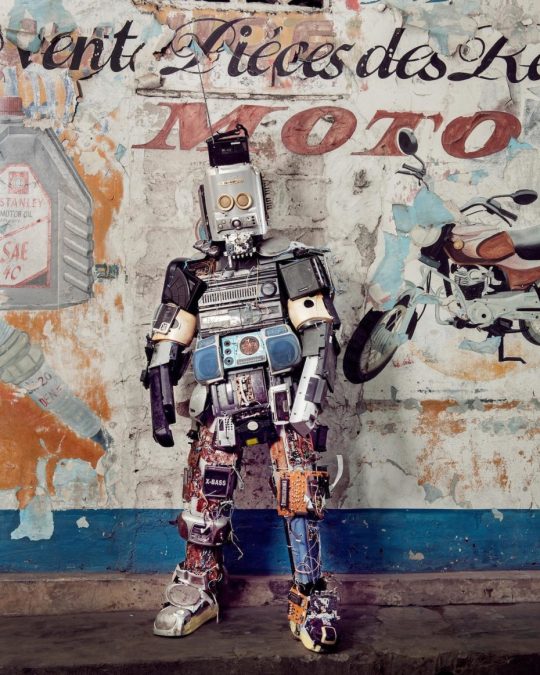
Stéphan Gladieu/National Geographic
Congolese Artists Transform Garbage Into Garb To Take A Stand
In the Democratic Republic of the Congo, artists’ creations protest the country’s plight as a dump for global waste. After years studying at the Academy of Fine Arts, Kinshasa — following teachers’ advice on creating work with “proper” materials, such as resin and plaster of paris — some students in the Democratic Republic of the Congo (DRC) decided to do something different.
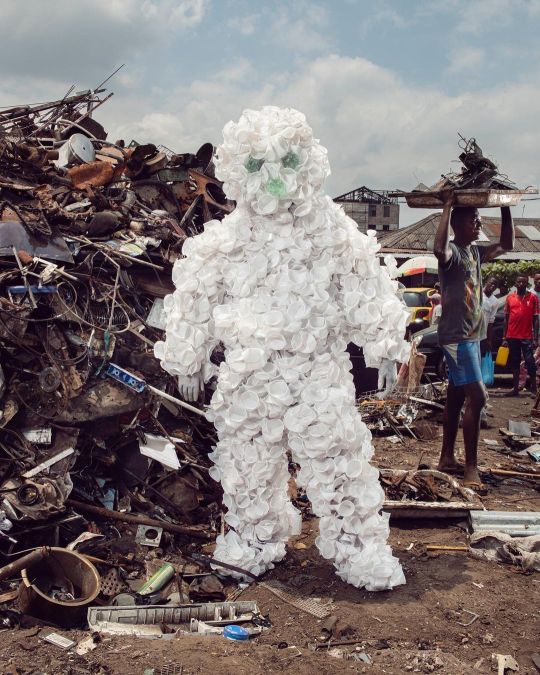
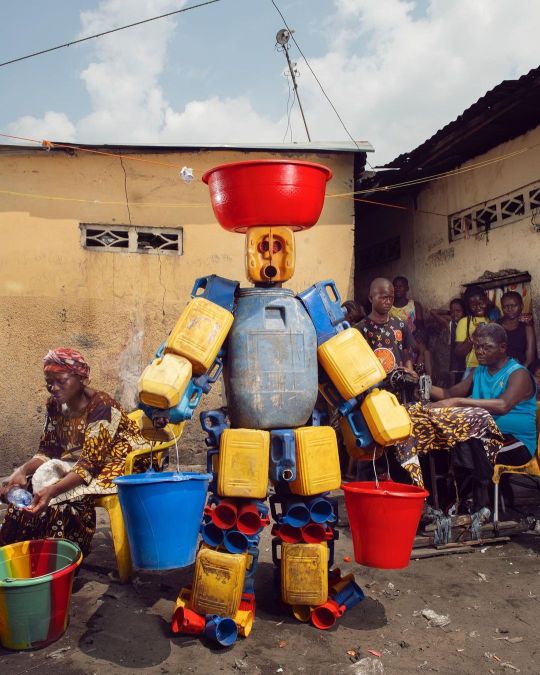
#democratic republic of congo#artists#garbage#art#academy of fine arts - kinshasa#congolese artists#global waste#stephan gladieu
1 note
·
View note
Text









Patrick Bongoy, Democratic Republic of Congo (b. 1980)
Patrick Bongoy was born in Kinshasa in the Democratic Republic of Congo and studied at the Academy of Fine Arts. He currently lives and works in Cape Town.
“My work speaks in response to the global reality of literal and figurative environmental pollution,” the artist states. “This encompasses the entire spectrum from the erosion of economic viability for people, sociocultural decay impacting on community and individual behaviour and natural rural and urban landscape.”
The textured surface of his works are the result of a painstaking process of cutting and weaving together strips of hessian and rubber. This complex technique, carefully layered in a three-dimensional relief, draw on traditional basket making skills while referencing the difficult colonial histories and physical labour which defines day to day living in the DRC.
https://www.thkgallery.com/.../35-patrick-bongoy/overview/
18 notes
·
View notes
Text
Photography! Rubbish Fashion: Street Art Costumes Of Kinshasa – In Pictures
In his series Fulu Act, Brussels-based documentary photographer Colin Delfosse captures street artists in Kinshasa, who craft striking costumes out of everyday objects found littering the streets, such as discarded wigs, wires, soda cans and bottle lids, to raise awareness of environmental issues facing the Democratic Republic of the Congo. “The statement behind their costumes is to condemn and inform about overconsumption and its side effects, namely pollution, poverty, lack of reliable investments and so on,” says Delfosse. “By capturing these images, I’m giving an echo to their crucial work.”
Colin Delfosse is shortlisted in the Sony world photography awards 2023. An exhibition of the photographs is at Somerset House, London, 14 April-1 May

Congolese Artist Nada Thsibwabwa posing in his mobile phone costume in Matongé district, Kinshasa. Thirty per cent of coltan, a key mineral for smartphone production, comes from the DRC. Yet every new smartphone has to be imported to the DRC at high cost. Kinshasa is a big market for secondhand phones from all ever the world. In Matongé, a whole market is dedicated to repairing old phones.

Congolese artist Hemock Kilomboshi posing in his rubber costume in Matonge district, Kinshasa. A member of the Kinact platform, Kilomboshi performs in Kinshasa’s streets to raise issues about globalisation and economic plunder in the DRC.

Congolese artist Jean Precy Numbi Samba, AKA Robot Kimbalambala, pictured in his costume made of car spare parts in the Ngiri-Ngiri district, Kinshasa, December 2019. The car market in the capital’s suburbs is mostly made of highly polluting secondhand (or thirdhand) vehicles from Europe.

Junior Lohaka Tshonga in his Bolole Nkemi (‘I’m the idiot’) costume. Junior Is a painter and performer trained at the Academy of Fine Arts in Kinshasa. For several years the artist has been working on the theme of plastic, recycling plastic bottles found in the rivers of Kinshasa.

Abdoulaye Kinzonzi Kiakanda posing in his plastic water bag costume in Selembao district, Kinshasa. In Kinshasa and throughout the country, itinerant street vendors sell sachets of drinking water. Once used, these bags are thrown on the ground, causing mountains of waste. Abdoulaye recycled them into a suit.

Falonne Mambu posing in her electric wires costume in Limete district, Kinshasa. As a performing artist, she raises issues about social development in her own country. The Democratic Republic of the Congo is potentially the biggest electricity provider in sub-Saharan Africa. Unfortunately, decay and corruption have crippled the national Inga dam, which only works to the minimum of its capacity. Nowadays, only 19% of Congolese people have access to electricity.

Artist Junior Lohaka Tshonga posing in his spacesuit in Kinshasa. His suit is a metaphor for protection against ambient pollution in the city – a way to protect the body from toxic materials.

Congolese artist Florian Sinanduku posing in his pill costume in Selembao district. ‘In Kinshasa, and in the whole country, finding medicine is still a big issue. You never know where it comes from and what it is made of. You can find pills everywhere, but most of them are coming from China, and came here without any control,’ says Sinanduku.
1 note
·
View note
Photo

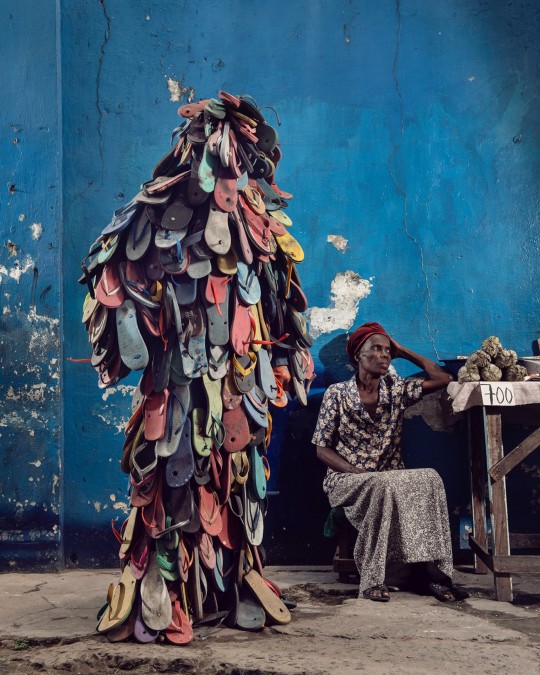
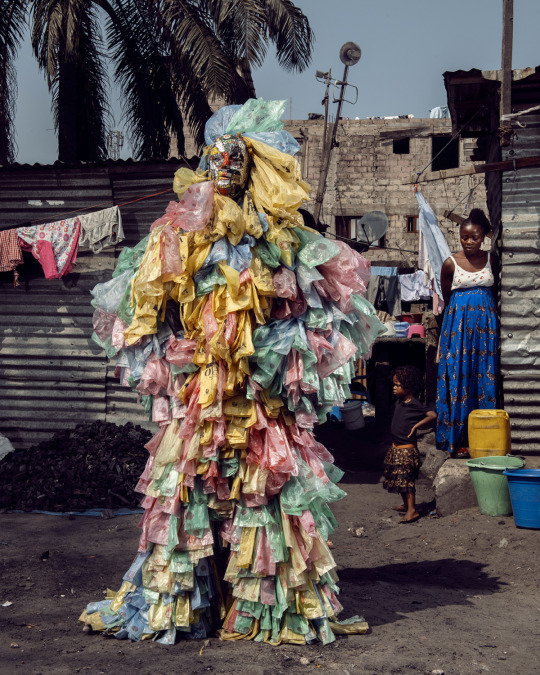
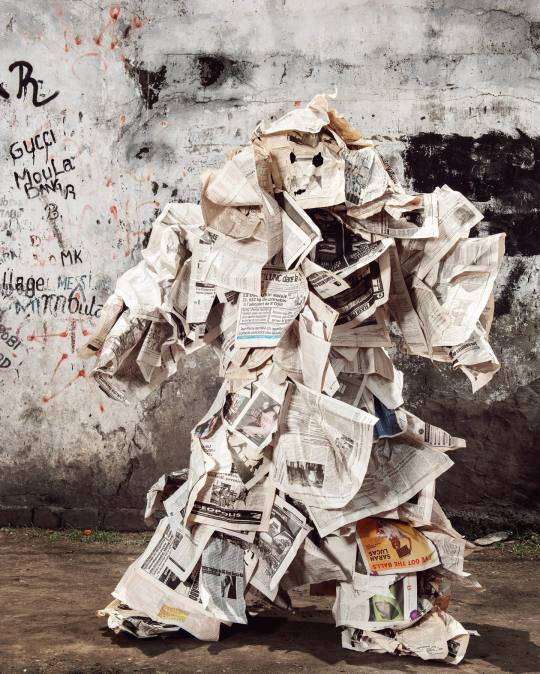
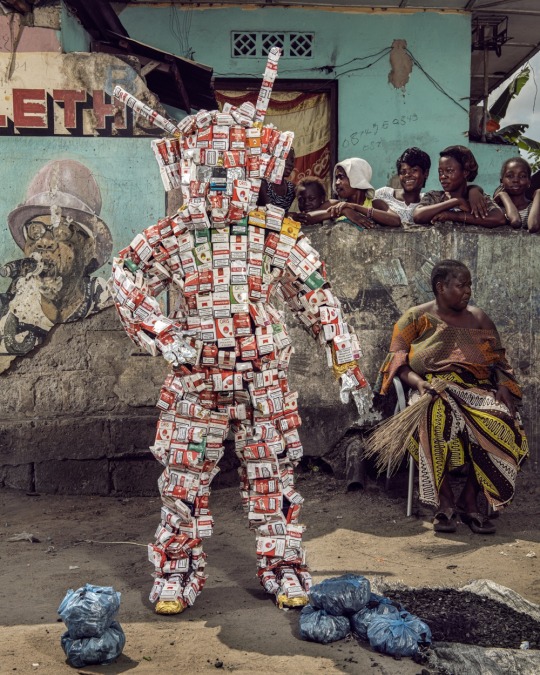





Transforming Trash into Protest Art
The second largest country in Africa, the Democratic Republic of Congo has one of the richest sub-soils in the world in gold, coltan, diamonds, cobalt, oil... and yet remains the 8th poorest country on the planet.
The Congolese are among the biggest losers of globalisation. They rarely benefit from the products manufactured with the resources drawn from their country. In general, these products reappear in Africa in the third or fourth generation; at best they are outdated, but more often than not, they are no more than the waste products of industrialised countries that prefer to relocate their processing.
The DRC is experiencing an ecological scandal, but just as an alchemist transforms lead into gold, "Ndaku, la vie est belle" was born from these tons of rubbish. It was founded six years ago in Kinshasa by the artist Eddy Ekete, and today it brings together nearly 25 artists, almost all of whom were trained at the Kinshasa Academy of Fine Arts.
Painters, singers, visual artists and musicians have joined forces to denounce the tragedy of their daily lives, the wars that have resulted from them, the exploitation of women and men that stems from them and ferments the unfathomable misery that robs them of their dignity.
Originally, these artists had in common that they had no resources, no support and that they lived in a shanty town in Kinshasa, built on land filled with tons of untreated waste. Naturally, they found an abundance of free raw material in these remains.
Mobile phones, plastic, corks, everything is raw material - and yet already industrialised! - to denounce the chaos in which the country is kept.
If Congo Kinshasa has partly lost its animist and mystic traditions under the pressure of Catholicism and colonisation, the artists of the collective "Ndaku, la vie est belle" return to the traditional source of the African mask.
Courtesy of Stephan Gladieu
#art#congo#DRC#trash#sustainability#equal rights#stephan gladieu#mask#africa#sustainable development#eddyekete#upcycling#recycling#streetart#human rights#ecology#fashion#costumes#kinshasa#globalisation#ndaku#poetry#hope
219 notes
·
View notes
Photo

🎨#ArtIsAWeapon #ExhibitClosing SYNERGIES Community: Equity: Elan Cadiz Cartography: Scarification: Alexandre Kyungu Mwilambwe at @calabargallery, closes next week Thursday, February 3. Reposted from @calabargallery: SYNERGIES is a conversation between the work of two artists: North American and New York based #ElanCadiz @elanhiart and Congolese And Kinshasa based #AlexandreKyunguMwilambwe @studioalexandrekyungu_ about mapping their journey's through art ideas and life. Each is a series of pivotal stories capturing community through geography, places, people and moments. Both are using ethnographic processes, material and mediums as well as techniques to talk about equity, migration and the cities they inhabit and work in. Elan Cadiz is an interdisciplinary North American Visual Artist that deconstructs and balances her intersectionality through her projects. Her art and practice are grounded in the documentation of her personal narrative through the use of historical imagery and the domestic. Elan Cadiz graduated from City College of New York with a BA in Studio Art and a MFA Fine Art from SVA Alexandre Kyungu Mwilambwe (born in 1992, Kinshasa D.R.Congo) lives and works in Kinshasa, Democratic Republic of Congo. He studied art at the Academy of Fine Arts in Kinshasa. He is co-founder of the group Vision Total (vi.to) and works in collaboration with Kin Art Studio (KAS). Alexandre Kyungu is an artist whose work explores the imaginary between mapping and scarification of the body. He combines #painting, #drawing, #sculpture, and #installation in his practice as an artist. However, his work explores all ideas of migration and identity, borders and space, signs, and symbols. Calabar Gallery 2504 Frederick Douglass Blvd New York, NY 10030 ☎️646-964-5062 Hours: Wednesday to Sunday, 12pm to 7pm Masks and Vaccination required Register to attend https://www.eventbrite.com/e/synergies-equity-elan-cadiz-scarification-alexandre-kyungu-mwilambwe-tickets-231920449307 Interested in acquiring work, email [email protected] #calabargallery #Synergies #BlackArt #BlackArtLovers #africanart #Artcollectors #BlackGirlArtGeeks #ArtExhibits #ArtAndTheCity https://www.instagram.com/trascapades/p/CZPTDywrA8H/?utm_medium=tumblr
#artisaweapon#exhibitclosing#elancadiz#alexandrekyungumwilambwe#painting#drawing#sculpture#installation#calabargallery#synergies#blackart#blackartlovers#africanart#artcollectors#blackgirlartgeeks#artexhibits#artandthecity
1 note
·
View note
Photo

BREAKING THE MOULD: New Signatures from the Democratic Republic of Congo
Curated by Christine Eyene
14 October – 28 November 2021
198 Contemporary Arts and Learning 198 Railton Road, London SE24 0JT
BREAKING THE MOULD: New Signatures from the Democratic Republic of Congo features the work of 12 emerging artists from DRC, predominantly former students of the Academy of Fine Arts in Kinshasa, who are breaking the boundaries of academic training and developing new forms of visual explorations.
The artists are: Arlette Bashizi, Beau Disundi, Ghislain Ditshekedi, Godelive Kasangati, Anastasie Langu, Jamil Lusala, Catheris Mondombo, Arsène Mpiana, Stone Mutshikene, Chris Shongo, Ange Swana and Joycenath Tshamala.
For this exhibition, curator Christine Eyene has selected over fifteen art works and series comprising painting, photography, mixed-media and installation pieces that reflect the new ideas, aesthetics and discourses emerging from the heart of Africa.
This exhibition marks the reopening of the newly redeveloped 198 Contemporary Arts and Learning and is funded by Yetu – Property Investment Club and Arts Council England.
More information
image: Chris Shongo, Nefercongo (series), 2019. Courtesy the artist.
0 notes
Text
Kinshasa - The third largest city in Africa

Kinshasa is the capital and largest city of the Democratic Republic of the Congo. Kinshasa is located on the Congo River, and is the third largest city in Africa. It is also the second largest French speaking city in the world, after Paris. Kinshasa is the main economic, commercial, administrative, and cultural centre of the Democratic Republic of Congo. Kinshasa has several attractions, including Cité de L'oua, home to the country’s government; Quartier Matonge, known regionally for its nightlife; L'onatra, the impressive building of the Ministry of Transport; and the residential area of Gombe. Other notable attractions include the Kinshasa Museum, the Kinshasa Fine Arts Academy, the central market, and several skyscrapers, showing the city’s recent modernisation.
Here are some of the top places to visit in Kinshasa
Congo River
Garamba National Park
Livingstone Falls
Lola ya Bonobo Sanctuary
Salonga National Park
Pool Malebo
Petites Chutes de la Lukaya
Kisantu Botanical Gardens
Kinkole fish Market
Jardin d'Eden
Things to do in Kinshasa
Get lost in Kinshasa
Visit the Lola Ya Bonobo
Take a break at the Kahuzi Biega National Park
Explore the Nyiragongo Volcano
Visit the Virunga National Park
Stroll around Garamba National Park
Visit the Brazzaville
Spend some time at the Salonga National Park
Marvel at the Falls of Zongo
Go on a boat ride to Idjwi
Read More:- https://blog.travelcenter.uk/kinshasa-the-third-largest-city-in-africa/
This Article, Information & Images Source (copyright) :- https://blog.travelcenter.uk
#travel#travelcenteruk#travelvibes#wanderlust#traveller#travellife#travelgoals#bestplacetotravel#Kinshasa
0 notes
Photo









Kinshasa, capital of the Democratic Republic of Congo, held it’s first contemporary art biennale on November 21- December 19 in 2014. In the spirit of the biennale which take place in Dakar and Kampala, Kinshasa show-cased thirty-five artists from all continents and twenty Congolese artists, including it’s acclaimed artists Freddy Tsimba and Kura Shomali. The biennale was organized around the theme “Yango” means ‘Forward’ in lingala, and sought to explore aspects of Congolese representation, as well as urban space and globalization.
(Watch an interview with Freddy Tsimba on 20min.fr)
Organized by photographer and filmmaker Kiripi Katembu Siku, and curated by art collector Sithambile Mlotshwa, the exhibition took place on 4 sites: The Exchanger Limete, the Academy of Fine Arts, the French Institute of Kinshasa and the Centre Wallonie Bruxelles
Forward, but to where? In what direction? It’s knowing where to look and we seek to overcome this reality. It’s aware of what we can offer and transform. It’s to question other’s look around one’s self, of one’s self and on others. This is an opportunity to look at us and enrich us with others. - yangobiennale.org
Image sources Michel Ekeba Le Point Afrique Isaac Cordal Nils Ramhoj
0 notes
Text
Lois Mailou Jones






Lois Mailou Jones (November 3, 1905 – June 9, 1998) was an artist who painted and influenced others during the Harlem Renaissance and beyond, during her long teaching and artistic career. Jones was the only African-American female painter of the 1930s and 1940s to achieve fame abroad, and the earliest whose subjects extend beyond the realm of portraiture. She was born in Boston, Massachusetts and is buried on Martha's Vineyard in the Oak Bluffs Cemetery.
Early life and education
Her father, Thomas Vreeland Jones was a building superintendent who later became a lawyer after becoming the first African-American to earn a law degree from Suffolk Law School; her mother, Carolyn Jones was a cosmetologist.
Jones' parents encouraged her to draw and paint as a child in water color. During childhood her mother took her and her brother to Martha's Vineyard where she became lifelong friends with novelist Dorothy West. She attended the High School of Practical Arts in Boston. Meanwhile, she took Boston Museum of Fine Arts evening classes and worked as an apprentice in costume design. She held her first solo exhibition at the age of 17. From 1923 to 1927 she attended the School of the Museum of Fine Arts in Boston studying design, taking night courses at the Boston Normal Art School. She also pursued graduate work at the Design Art School and Harvard University. She continued her education even after beginning work, attending classes at Columbia University and receiving her bachelor's degree from Howard University in 1945, graduating magna cum laude.
Work
In 1928 she was hired by Charlotte Hawkins Brown after some initial reservations, and founded the art department at Palmer Memorial Institute in North Carolina. As a prep school teacher, she coached a basketball team, taught folk dancing, and played the piano for church services. Only one year later, she was recruited to join the art department at Howard University in Washington D.C., and remained as professor of design and watercolor painting until her retirement in 1977. While developing her own work as an artist, she was also known as an outstanding mentor.
In 1934 Jones met Louis Vergniaud Pierre-Noel, who would become a prominent Haitian artist, while both were graduate students at Columbia University. They corresponded for almost twenty years before marrying in the south of France in 1953. Jones and her husband lived in Washington, D.C. and Haiti. They had no children. He died in 1982.
In the early 1930s Jones exhibited with the William E. Harmon Foundation and other institutions, produced plays and dramatic presentations and began study of masks from various cultures. In 1937 she received a fellowship to study in Paris at the Académie Julian. During one year's time she produced over 30 watercolors. She returned to Howard University and began teaching watercolor painting. She said of her time in Paris:
The French were so inspiring. The people would stand and watch me and say 'mademoiselle, you are so very talented. You are so wonderful.' In other words, the color of my skin didn't matter in Paris and that was one of the main reasons why I think I was encouraged and began to really think I was talented.
In 1938 she produced Les Fétiches (1938) a stunning, African inspired oil which is owned by the Smithsonian American Art Museum, Jones' Les Fétiches was instrumental in transitioning 'Négritude'—a distinctly francophone artistic phenomenon—from the predominantly literary realm into the visual. Jones' work provided an important visual link to Négritude authors including Aimé Césaire, Léon Damas, and Léopold Sédar Senghor. It was one of her best known works, and her first piece which combined traditional African forms with Western techniques and materials to create a vibrant and compelling work. She also completed Parisian Beggar Womanwith text supplied by Langston Hughes.
Her main source of inspiration was Céline Marie Tabary, also a painter, whom she worked with for many years. Tabary submitted Jones' paintings for consideration for jury prizes since works by African-American artists were not always accepted. Jones traveled extensively with Tabary, including to the South of France, and they frequently painted each other. They taught art together in the 1940s.
In the 1940s and early 1950s Jones exhibited at the Phillips Collection, Seattle Museum of Art, National Academy of Design, the Barnet Aden Gallery, Pennsylvania's Lincoln University, Howard University, galleries in New York and the Corcoran Gallery of Art. In 1952 Loïs Mailou Jones: Peintures 1937-1951, a collection of more than 100 reproductions of her French paintings, was published.
In 1954 Jones was a guest professor at Centre D'Art and Foyer des Artes Plastiques in Port-au-Prince, Haiti where the government invited her to paint Haitian people and landscapes. Her work became energized by the bright colors. She and her husband returned there during summers for the next several years, in addition to trips to France. There she completed "Peasant girl, Haiti" and also exhibited her work. In 1955 she unveiled portraits of the Haitian president and his wife commissioned by United States President Dwight D. Eisenhower.
Jones's numerous oils and watercolors inspired by Haiti are probably her most widely known works. In them her affinity for bright colors, her personal understanding of Cubism's basic principles, and her search for a distinctly style reached an apogee. In many of her pieces one can see the influence of the Haitian culture, with its African influences, which reinvigorated the way she looked at the world. These include Ode to Kinshasa and Ubi Girl from Tai. Her work became more abstract and hard-edged, after her marriage to Pierre-Noel. Her impressionist techniques gave way to a spirited, richly patterned, and brilliantly colored style.
In 1962 she initiated Howard University's first art student tour of France, including study at Académie de la Grande Chaumière and guided several more tours over the years. In the 1960s she exhibited at School of the Museum of Fine Arts, Boston, Cornell University, and galleries in France, New York and Washington, D.C.
In 1968 she documented work and interviews of contemporary Haitian artists for Howard University's "The Black Visual Arts" research grant. And continued the project in 1969 and 1970, traveling to eleven African countries. Her report Contemporary African Art was published in 1970 and in 1971 she delivered 1000 slides and other materials to the University as fulfillment of the project. In 1973-74 she researched "Women artists of the Caribbean and Afro-American Artists."
Her research inspired Jones to synthesize a body of designs and motifs that she combined in large, complex compositions. Jones's return to African themes in her work of the past several decades coincided with the black expressionistic movement in the United States during the 1960s. Skillfully integrating aspects of African masks, figures, and textiles into her vibrant paintings, Jones continued to produce exciting new works at an astonishing rate of speed, even in her late eighties. In her nineties, Jones still painted. Bill Clinton and Hillary Clinton collected one of her island seascapes Breezy Day at Gay Head while they were in the White House.
Jones felt that her greatest contribution to the art world was "proof of the talent of black artists." The African-American artist is important in the history of art and I have demonstrated it by working and painting here and all over the world." But her fondest wish was to be known as an "artist"—without labels like black artist, or woman artist. She has produced work that echoes her pride in her African roots and American ancestry.
Lois Mailou Jones' work is in museums all over the world and valued by collectors. Her paintings grace the permanent collections of the Metropolitan Museum of Art, Smithsonian American Art Museum, Hirshhorn Museum and Sculpture Garden, National Portrait Gallery, Boston Museum of Fine Arts, the National Palace in Haiti, the National Museum of Afro-American Artists and many others.
Awards and honors
Robert Woods Bliss Award for Landscape for Indian Shops Gay Head, Massachusetts(1941)
Atlanta University award for watercolor painting Old House Near Frederick, Virginia (1942)
Women of 1946 award from the National Council of Negro Women (1946)
John Hope Prize for Landscape for Ville d'Houdain, Pas-de-Calais and award from the Corcoran Gallery of Art for Petite Ville en hautes-Pyrenées (1949)
Atlanta University award for Impasse de l'Oratorie, Grasse, France (1952)
Chevalier of the National Order of Honor and Merit from the government of Haiti. (1954)
Award for design of publication Voici Hätii (1958)
Atlanta University award for Voodoo Worshippers, Haiti and America's National Museum of Art award for Fishing Smacks, Menemsha, Massachusetts (1960)
Elected Fellow of The Royal Society of Arts in London; receives Franz Bader Award for Oil Painting from National Museum of Art for Peasants on Parade (1962)
Howard University Fine Arts Faculty Award for Excellence in Teaching (1975)
Honorary Doctorate of Humane Letters from Suffolk University in Boston. She also has received honorary degrees from Colorado State Christian University, Massachusetts College of Art
Honored by President Jimmy Carter at the White House for outstanding achievements in the arts (1980).
Candace Award, Arts and Letters, National Coalition of 100 Black Women (1982)
Legacy
After her death, her friend and adviser, Dr. Chris Chapman completed a book about her life and the African-American pioneers she had worked with and been friends with, including Dr. Carter G. Woodson, Alain Locke, Dorothy West, Josephine Baker, and Matthew Henson. Entitled Lois Mailou Jones: A life in color, it is available through Xlibris and museum stores.
In 1997, Jones' paintings were featured in an exhibition entitled Paris, the City of Light that appeared at several museums throughout the country including the New Orleans Museum of Art, the Milwaukee Art Museum, and the Studio Museum of Harlem. The exhibition also featured the works of Barbara Chase-Riboud, Edward Clark, Harold Cousins, Beauford Delaney, Herbert Gentry, and Larry Potter. The exhibition examined the importance of Paris as an artistic mecca for African-American artists during the 20 years that followed World War II.
From November 14, 2009, to February 29, 2010, a retrospective exhibit of her work entitled Lois Mailou Jones: A life in vibrant colorwas held at the Mint Museum of Art in Charlotte, North Carolina. The traveling exhibit included 70 paintings showcasing her various styles and experiences: America, France, Haiti, and Africa.
Wikipedia
2 notes
·
View notes
Text
Where To Drink Coffee In Brussels
A walk in the park, Brussels is not. In the Belgian capital, contrasts between the well-off and those in need can be stark. Street names and signs are given in two languages, though neighborhoods and their inhabitants tend to identify as either Francophone or Flemish-speaking, sometimes leading to notoriously nationalist identity politics and social strife. Majestic though they are, many of the monumental buildings look like they are forever in need of a power wash.
Despite these complexities, not to mention the city’s Eurocratic solemnity—it is known as the European Union’s “de facto capital” (the title itself evoking bureaucratic provisos and red tape)—Brussels’ mascot is the Manneken Pis. That this simple little statue of a naked boy urinating into a fountain attracts so much attention and celebration reminds us that humor and joie de vivre also exist here. So do chocolates galore, among many other famous local sweets (waffles, nougat) and treats (mussels, beer). Meanwhile, a contrast to all the traditionalist Belgian gastronomy is the novelty of specialty coffee. The scene is still young and the cafes are still very much countable, but that makes it all the more exciting. Here, then, are a variety of venues worth a visit.
OR Coffee
Its name is a conjunction connecting choices, but visiting OR Coffee should not be a matter of choice when in Brussels. Many would agree that this brand brought specialty coffee to the Belgian capital, over a decade after Katrien Pauwels and Tom Janssen founded their own roastery in 2001. Today the couple has two cafes in Brussels, two in Ghent, and the OR coffee school and roastery in Westrem.
Flanked by a Marriott Hotel and a Bobbi Brown store, the Brussels’ city-center location, which opened in 2012, attracts a cross-section of clients, whose Flemish, French, and English conversations bounce animatedly off the bi-level brick walls. Coffee orders—taken at the counter but delivered to tables—might range from traditional espresso-based milk beverages to the most pronouncedly pampelmousse Kenyan à la Kalita this reporter has ever experienced. And in the Dutch and Flemish tradition, drinks are served with a little sweet on the side: here, a chocolate in OR’s signature forest green and gold packaging.
An estimated 95% of OR’s coffee is “direct fair trade,” says the company’s head of education, Wouter Helsen. This choice is facilitated by the close working relationship with Pauwels’ other business, Cup-A-Lot green coffee sourcers, and she and Janssen’s ability to personally travel to origin countries.
For equally appealing offerings and service, visit OR’s second Brussels branch in the municipality of Etterbeek. This cafe attracts the darker-suited set with business in and among the nearby European Commission and provides, for the coffeecrats among us, the cool sight of a Pentair water filter system with customized copper tubing wall-mounted like an objet d’art.
OR Coffee Roasters is located at Rue A. Ortsstraat 9, 1000 Brussel. Visit their official website and follow them on Facebook and Instagram.
MOK
Like OR, MOK has its roots, roastery, and first coffee bar in Flanders, but its Brussels outpost has become the company flagship. Though founder and owner Jens Crabbé says he once felt namer’s remorse for the obvious choice—mok means “mug” in Flemish—he acknowledges it was an ode to filter coffee, experiencing a renaissance in the Low Countries when his business began almost eight years ago. And it remains fitting considering the scrutiny with which Crabbé develops his roasting profiles and brew recipes; unsurprisingly, he is Belgium’s reigning Cup Tasters Champion.
“It started off maybe quite small and cute and then, as I grew as a person,” says Crabbé, now just shy of 30, “my style started to change, and the brand kind of followed.”
With high ceilings, a communal table, a custom-designed shelving-cum-blackboard unit, and an open kitchenette producing vegetarian-friendly cold and hot breakfast and lunch, MOK is progressive in its aesthetics and taste. Being situated on the fashionable Rue Antoine Dansaert—from A.P.C. to Kartell, stylistas can shop in a straight line—is fitting, though MOK deftly balances chic and geek.
Jens Crabbé
Riffing about MOK’s reverse-osmosis system and the different hardnesses for espresso and filter, Crabbé notes: “When people buy coffee we even encourage them [by saying], ‘Hey, take half a liter of water home from the tap, try it at home with our water. Water is really important, and we really try to like tick all the boxes to give you a good coffee experience.’”
Inasmuch as Crabbé enjoys living and working in his hometown of Leuven, he is seeking a new roasting space for MOK in the Belgian capital. “There’s a lot of work to be done still in Brussels in coffee, and we really want to be a part of that,” he says.
MOK is located at Rue Antoine Dansaert 196, Brussels. Visit their official website and follow them on Facebook and Instagram.
Fika
From light roasts in specialty coffee to clean lines in interior design, Scandinavia has contributed much to contemporary cafe culture around the world. In Brussels, however, Scandic style has yet to become big. And when Joana Soulard opened her homage to the Swedish coffee break in fall 2016, it was simply a commonsensical melding of two of her interests: specialty coffee and Scandinavian culture.
For filter preparations, Fika uses coffee roasted by April (founded by, indeed, a Swede), and is known to include Swedish favorites among its on-premise-baked pastries. “We have some Swedish [customers], but they come for the semla,” admits Soulard.
Of Fika’s city-central neighborhood, “it’s very mixed,” she says. The Matongé, as it is commonly known, is named after a district in Kinshasa, DR Congo, recognizing the many Congolese immigrants who have settled in the area over the last half-century; these days they are joined by other African communities and European Union-employed expats.
Fika does a lot of weekday morning takeaway, though during the day provides a peaceful spot to sit and sip. The venue, like its owner, is relaxed yet engaging; characteristically light wood and soft lines create a sense of holding space and hygge. That said, a non-Nordic nod goes to Café Capitale, the Brussels brand that supplies Fika’s espresso beans and a company whom Soulard credits with teaching her “everything about coffee” during her four-year employment there.
“For me, it’s important to use and to have some local products,” she adds.
Fika is located at Rue de la Paix 17, Brussels. Follow them on Facebook and Instagram.
Café Capitale
Café Capitale is a crowd pleaser. Perhaps this is because founder François Lafontaine established his company in 2001 with ambience very much in mind, aiming for “cool places to drink coffee,” as he put it in a Coffee with April podcast. But fast-forward a dozen years, after inspiring visits to Sydney and Melbourne—having discovered “places where you sell only classic basic milk drink and filter coffee, with no whipped cream, no syrup and no topping and a huge line of customers”—Lafontaine rebranded and renamed his business. His focus turned to specialty coffee and he plunged into SCA courses, eventually becoming a certified roaster and Q grader.
Nowadays, Lafontaine owns and runs an atelier and bakery in nearby Uccle, the Brussels-based Belgian Coffee Academy, which has a roastery and a training center, and two cafes in Brussels.
The Café Capitale on Rue du Midi, which dates back to 2001, occupies a busy corner near the city’s iconic square, the Grand-Place. Vinyl spins on a turntable behind the bar and illustrations of coffee apparatuses act simultaneously as wall art and a visual education.
Alongside espresso-based drinks and filter coffees—V60 is the default, though AeroPress and Chemex are also available—the menu lists “three aromatic coffees from the past,” as Lafontaine terms them: “the mochaccino, the caramel macchiato, and the cappuccinut.” This reporter found the last—a syrup-sweetened hazelnut crunch-topped cappuccino—a perfect pre-prandial pick-me-up. And for those who prefer not to nibble from a drink, but rather, a dish, there is breakfast, lunch, and snack fare, with many of the carbohydrates produced by Café Capitale’s own bakery.
Less spacious but no less enticing, the branch on Rue Ernest Allard is in Sablon, just a 10-minute walk south.
Café Capitale is located at Rue du Midi 45, 1000 Bruxelles. Visit their official website and follow them on Facebook and Instagram.
Aksum Coffee House
At Aksum Coffee House, do not expect an array of filter choices—in fact, on a recent visit, there was none on the menu, though a barista happily obliged when asked for one—nor conversations about water hardness and fruit-forward roast profiles. Be prepared, however, for a fine selection of espresso beans exclusively from Ethiopia, teas, chocolate, and baked goods, as well as a cost-free feast for the eyes in the form of rotating wall art by local street artists.
The Aksum brand has been around for a decade, but investor Vinod Gautam took it over about five years ago and, with the avid help of manager Fatima Boulben, began focusing on what Gautam calls organic, mainly small-cooperative-sourced Harar, Sidamo, Yirgacheffe, and Limu coffees roasted by Aksum’s own roastery. Though neither is Ethiopian—he is from India; her parents are from Morocco—the duo is intent on sharing Ethiopian coffee with the masses, and have ambitions to one day host Ethiopian dance and coffee ceremonies in Brussels.
Aksum Coffee House currently has three Brussels locations, though the most spectacular is in the renowned Saint-Hubert Royal Galleries, a 19th-century European shopping arcade (read: proto-mall). The Embassy of Ethiopia’s quarterly magazine called this branch, which opened in July 2017, “the temple of Ethiopian coffee in the city.”
Amidst the arcade’s Old World boutiques and high-end chocolatiers, it radically offers a hangout spot, with friendly staff and room enough for small groups to share a table or solitary laptop workers to concentrate.
As Boulben describes her vision of Aksum: “It has to be a place where everybody should feel comfortable. From the high social level to the normal social level, they should all feel comfortable, because you know when you say ‘specialty coffee’ people straightaway feel afraid this is expensive.”
Aksum is located at Rue des Chapeliers 17, 1000 Bruxelles. Visit their official website and follow them on Facebook and Instagram.
Karina Hof is a Sprudge staff writer based in Amsterdam. Read more Karina Hof on Sprudge.
The post Where To Drink Coffee In Brussels appeared first on Sprudge.
Where To Drink Coffee In Brussels published first on https://medium.com/@LinLinCoffee
0 notes
Text
Where To Drink Coffee In Brussels
A walk in the park, Brussels is not. In the Belgian capital, contrasts between the well-off and those in need can be stark. Street names and signs are given in two languages, though neighborhoods and their inhabitants tend to identify as either Francophone or Flemish-speaking, sometimes leading to notoriously nationalist identity politics and social strife. Majestic though they are, many of the monumental buildings look like they are forever in need of a power wash.
Despite these complexities, not to mention the city’s Eurocratic solemnity—it is known as the European Union’s “de facto capital” (the title itself evoking bureaucratic provisos and red tape)—Brussels’ mascot is the Manneken Pis. That this simple little statue of a naked boy urinating into a fountain attracts so much attention and celebration reminds us that humor and joie de vivre also exist here. So do chocolates galore, among many other famous local sweets (waffles, nougat) and treats (mussels, beer). Meanwhile, a contrast to all the traditionalist Belgian gastronomy is the novelty of specialty coffee. The scene is still young and the cafes are still very much countable, but that makes it all the more exciting. Here, then, are a variety of venues worth a visit.
OR Coffee
Its name is a conjunction connecting choices, but visiting OR Coffee should not be a matter of choice when in Brussels. Many would agree that this brand brought specialty coffee to the Belgian capital, over a decade after Katrien Pauwels and Tom Janssen founded their own roastery in 2001. Today the couple has two cafes in Brussels, two in Ghent, and the OR coffee school and roastery in Westrem.
Flanked by a Marriott Hotel and a Bobbi Brown store, the Brussels’ city-center location, which opened in 2012, attracts a cross-section of clients, whose Flemish, French, and English conversations bounce animatedly off the bi-level brick walls. Coffee orders—taken at the counter but delivered to tables—might range from traditional espresso-based milk beverages to the most pronouncedly pampelmousse Kenyan à la Kalita this reporter has ever experienced. And in the Dutch and Flemish tradition, drinks are served with a little sweet on the side: here, a chocolate in OR’s signature forest green and gold packaging.
An estimated 95% of OR’s coffee is “direct fair trade,” says the company’s head of education, Wouter Helsen. This choice is facilitated by the close working relationship with Pauwels’ other business, Cup-A-Lot green coffee sourcers, and she and Janssen’s ability to personally travel to origin countries.
For equally appealing offerings and service, visit OR’s second Brussels branch in the municipality of Etterbeek. This cafe attracts the darker-suited set with business in and among the nearby European Commission and provides, for the coffeecrats among us, the cool sight of a Pentair water filter system with customized copper tubing wall-mounted like an objet d’art.
OR Coffee Roasters is located at Rue A. Ortsstraat 9, 1000 Brussel. Visit their official website and follow them on Facebook and Instagram.
MOK
Like OR, MOK has its roots, roastery, and first coffee bar in Flanders, but its Brussels outpost has become the company flagship. Though founder and owner Jens Crabbé says he once felt namer’s remorse for the obvious choice—mok means “mug” in Flemish—he acknowledges it was an ode to filter coffee, experiencing a renaissance in the Low Countries when his business began almost eight years ago. And it remains fitting considering the scrutiny with which Crabbé develops his roasting profiles and brew recipes; unsurprisingly, he is Belgium’s reigning Cup Tasters Champion.
“It started off maybe quite small and cute and then, as I grew as a person,” says Crabbé, now just shy of 30, “my style started to change, and the brand kind of followed.”
With high ceilings, a communal table, a custom-designed shelving-cum-blackboard unit, and an open kitchenette producing vegetarian-friendly cold and hot breakfast and lunch, MOK is progressive in its aesthetics and taste. Being situated on the fashionable Rue Antoine Dansaert—from A.P.C. to Kartell, stylistas can shop in a straight line—is fitting, though MOK deftly balances chic and geek.
Jens Crabbé
Riffing about MOK’s reverse-osmosis system and the different hardnesses for espresso and filter, Crabbé notes: “When people buy coffee we even encourage them [by saying], ‘Hey, take half a liter of water home from the tap, try it at home with our water. Water is really important, and we really try to like tick all the boxes to give you a good coffee experience.’”
Inasmuch as Crabbé enjoys living and working in his hometown of Leuven, he is seeking a new roasting space for MOK in the Belgian capital. “There’s a lot of work to be done still in Brussels in coffee, and we really want to be a part of that,” he says.
MOK is located at Rue Antoine Dansaert 196, Brussels. Visit their official website and follow them on Facebook and Instagram.
Fika
From light roasts in specialty coffee to clean lines in interior design, Scandinavia has contributed much to contemporary cafe culture around the world. In Brussels, however, Scandic style has yet to become big. And when Joana Soulard opened her homage to the Swedish coffee break in fall 2016, it was simply a commonsensical melding of two of her interests: specialty coffee and Scandinavian culture.
For filter preparations, Fika uses coffee roasted by April (founded by, indeed, a Swede), and is known to include Swedish favorites among its on-premise-baked pastries. “We have some Swedish [customers], but they come for the semla,” admits Soulard.
Of Fika’s city-central neighborhood, “it’s very mixed,” she says. The Matongé, as it is commonly known, is named after a district in Kinshasa, DR Congo, recognizing the many Congolese immigrants who have settled in the area over the last half-century; these days they are joined by other African communities and European Union-employed expats.
Fika does a lot of weekday morning takeaway, though during the day provides a peaceful spot to sit and sip. The venue, like its owner, is relaxed yet engaging; characteristically light wood and soft lines create a sense of holding space and hygge. That said, a non-Nordic nod goes to Café Capitale, the Brussels brand that supplies Fika’s espresso beans and a company whom Soulard credits with teaching her “everything about coffee” during her four-year employment there.
“For me, it’s important to use and to have some local products,” she adds.
Fika is located at Rue de la Paix 17, Brussels. Follow them on Facebook and Instagram.
Café Capitale
Café Capitale is a crowd pleaser. Perhaps this is because founder François Lafontaine established his company in 2001 with ambience very much in mind, aiming for “cool places to drink coffee,” as he put it in a Coffee with April podcast. But fast-forward a dozen years, after inspiring visits to Sydney and Melbourne—having discovered “places where you sell only classic basic milk drink and filter coffee, with no whipped cream, no syrup and no topping and a huge line of customers”—Lafontaine rebranded and renamed his business. His focus turned to specialty coffee and he plunged into SCA courses, eventually becoming a certified roaster and Q grader.
Nowadays, Lafontaine owns and runs an atelier and bakery in nearby Uccle, the Brussels-based Belgian Coffee Academy, which has a roastery and a training center, and two cafes in Brussels.
The Café Capitale on Rue du Midi, which dates back to 2001, occupies a busy corner near the city’s iconic square, the Grand-Place. Vinyl spins on a turntable behind the bar and illustrations of coffee apparatuses act simultaneously as wall art and a visual education.
Alongside espresso-based drinks and filter coffees—V60 is the default, though AeroPress and Chemex are also available—the menu lists “three aromatic coffees from the past,” as Lafontaine terms them: “the mochaccino, the caramel macchiato, and the cappuccinut.” This reporter found the last—a syrup-sweetened hazelnut crunch-topped cappuccino—a perfect pre-prandial pick-me-up. And for those who prefer not to nibble from a drink, but rather, a dish, there is breakfast, lunch, and snack fare, with many of the carbohydrates produced by Café Capitale’s own bakery.
Less spacious but no less enticing, the branch on Rue Ernest Allard is in Sablon, just a 10-minute walk south.
Café Capitale is located at Rue du Midi 45, 1000 Bruxelles. Visit their official website and follow them on Facebook and Instagram.
Aksum Coffee House
At Aksum Coffee House, do not expect an array of filter choices—in fact, on a recent visit, there was none on the menu, though a barista happily obliged when asked for one—nor conversations about water hardness and fruit-forward roast profiles. Be prepared, however, for a fine selection of espresso beans exclusively from Ethiopia, teas, chocolate, and baked goods, as well as a cost-free feast for the eyes in the form of rotating wall art by local street artists.
The Aksum brand has been around for a decade, but investor Vinod Gautam took it over about five years ago and, with the avid help of manager Fatima Boulben, began focusing on what Gautam calls organic, mainly small-cooperative-sourced Harar, Sidamo, Yirgacheffe, and Limu coffees roasted by Aksum’s own roastery. Though neither is Ethiopian—he is from India; her parents are from Morocco—the duo is intent on sharing Ethiopian coffee with the masses, and have ambitions to one day host Ethiopian dance and coffee ceremonies in Brussels.
Aksum Coffee House currently has three Brussels locations, though the most spectacular is in the renowned Saint-Hubert Royal Galleries, a 19th-century European shopping arcade (read: proto-mall). The Embassy of Ethiopia’s quarterly magazine called this branch, which opened in July 2017, “the temple of Ethiopian coffee in the city.”
Amidst the arcade’s Old World boutiques and high-end chocolatiers, it radically offers a hangout spot, with friendly staff and room enough for small groups to share a table or solitary laptop workers to concentrate.
As Boulben describes her vision of Aksum: “It has to be a place where everybody should feel comfortable. From the high social level to the normal social level, they should all feel comfortable, because you know when you say ‘specialty coffee’ people straightaway feel afraid this is expensive.”
Aksum is located at Rue des Chapeliers 17, 1000 Bruxelles. Visit their official website and follow them on Facebook and Instagram.
Karina Hof is a Sprudge staff writer based in Amsterdam. Read more Karina Hof on Sprudge.
The post Where To Drink Coffee In Brussels appeared first on Sprudge.
from Sprudge http://bit.ly/2Mp7wpG
0 notes
Photo
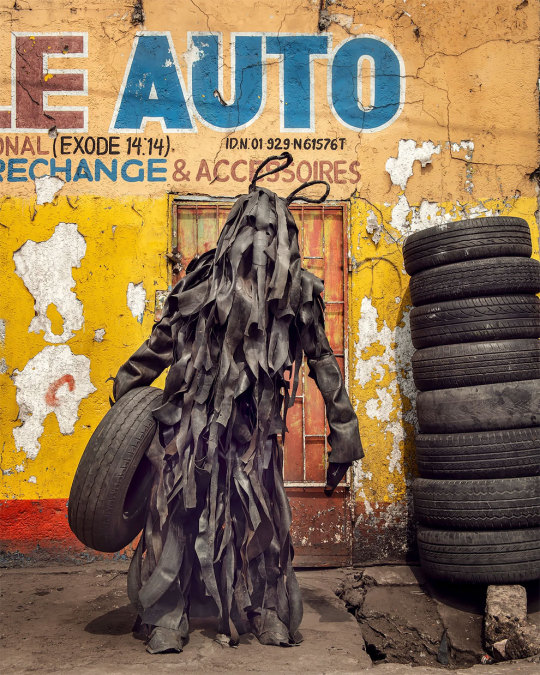
Stéphan Gladieu/National Geographic
Congolese Artists Transform Garbage Into Garb To Take A Stand
In the Democratic Republic of the Congo, artists’ creations protest the country’s plight as a dump for global waste. After years studying at the Academy of Fine Arts, Kinshasa — following teachers’ advice on creating work with “proper” materials, such as resin and plaster of paris — some students in the Democratic Republic of the Congo (DRC) decided to do something different.
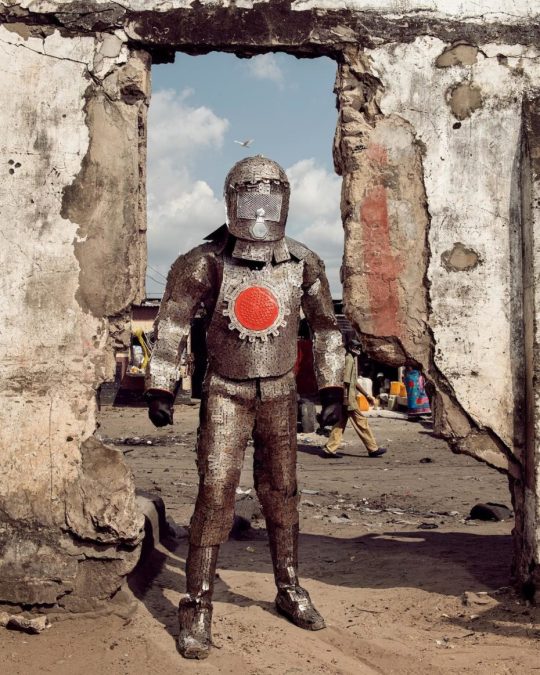
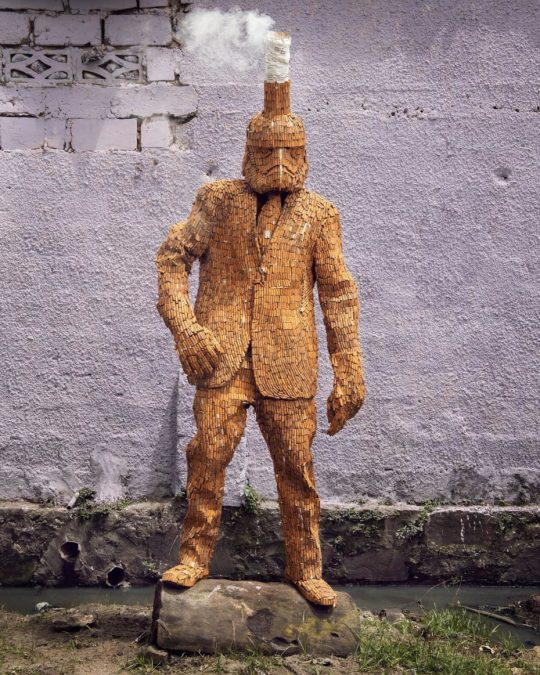
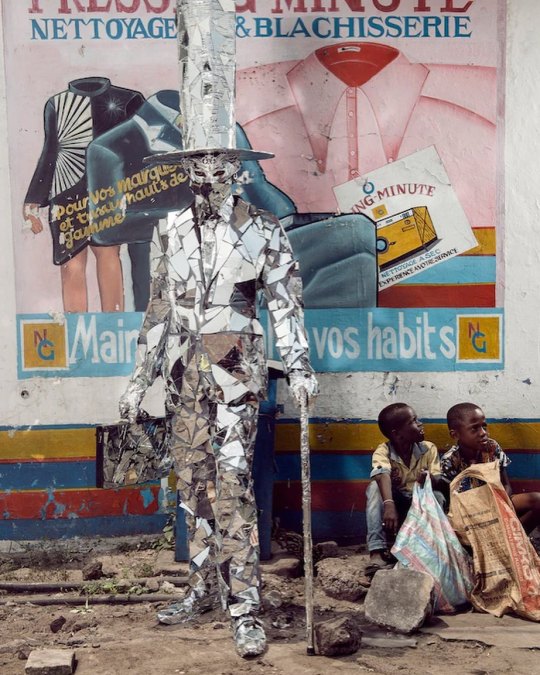
#democratic republic of congo#artists#art#congolese artists#garbage#global waste#academy of fine arts - kinshasa#stephan gladieu
1 note
·
View note
Text
These Artists Transform Garbage into Garb to Take a Stand
In the Democratic Republic of the Congo, artists’ creations protest the country’s plight as a dump for global waste.

Tire Man, by Savant Noir, is one of the sculpture–performance art creations that protest centuries of drain on the natural resources of the Democratic Republic of the Congo, including the taking of rubber to manufacture tires. Photographs By Stéphan Gladieu
— By AyodeJi Rotinwa | May 10, 2022
It started as a countercultural art movement in 2001.
After years studying at the Academy of Fine Arts, Kinshasa—following teachers’ advice on creating work with “proper” materials, such as resin and plaster of paris—some students in the Democratic Republic of the Congo (DRC) decided to do something different. They created art with what was in their immediate environment, including tires, exhaust pipes, foam, plastic bottles, antennas, tins that had held milk or paint, feathers, CDs, rubber slippers, and other discarded items.
This work, the artists believed, felt familiar to a Congolese audience and spoke to a particularly egregious aspect of Congolese life: waste.

Left: Patrick Kitete’s Flip-Flop Man features the rubber that goes into making inexpensive shoes. Stéphan Gladieu photographed these creations for projects that he names in scientific classification form, as if the costumed figures were new species: Homo trash trash and Homo detritus.
Bottom: Mvunzi Muteba, Jr., said he designed his character, Tin Can, to raise Africans’ awareness of how multinationals’ presence has affected Africa. Despite the continent’s riches, he says, “Africans still remain poor. They expect help from foreigners,” but he insists that multinationals, in fact, come to Africa “to steal, create conflicts, [and] finance armed groups.”
Right: For several years, Gladieu has photographed Kinshasan artists wearing attire they create from rubbish—here, Shaka Fumu Kabaka dresses as Razor Man. At first reluctant to take the photo, Gladieu says he couldn’t “deny the reality” of the artist’s chosen medium: The suit is made of razor blades, which youth gang members use to ritually cut their initiates.
Waste generated locally by citizens. Waste foisted on the country by hyper-consumerist nations. Waste triggered by the endless extraction of resources from the DRC’s earth, or the rapacious collection of the same above land.
In Kinshasa, gutters are brimming with nonrecyclable plastic bottles. Markets are awash with second- and thirdhand goods, castoffs from high-income countries and, at a quickening pace, China. In areas where international companies mine for cobalt—a precious component of smartphone batteries—frequent discharges contaminate river systems and surrounding life.
By repurposing waste to create sculpture and performance art, the artists wanted to dial up the public’s acuity toward an ongoing emergency. In 2015 they laid the groundwork for a collective to institutionalize the art: Ndaku Ya Life Is Beautiful, led by Eddy Ekete. A Kinshasa-born artist and social activist, Ekete also founded the KinAct festival, an annual showcase for the provocative creations. Increasingly, for the artists, the waste provides an opening to comment on fraught sociopolitical issues.

From Left: Artists ascribe meaning to their materials. Savant Noir puts feathers, which invoke ancestors’ aid, on a Western-style suit mocking rampant consumerism. Second from left : Arnold Etabe uses plastic rings to represent viruses. Third from Left: Kilomboshi Pape Noir turned cigarette waste into the figure of Butt Man, Gladieu says, as a reminder “that although the butt is very small, it is still very polluting”—full of toxins, such as lead, formaldehyde, and arsenic, and slow to decompose. Right: Making a figure out of automobile parts was Precy Numbi’s way of protesting the millions of “garbage cars” imported into Africa every year—secondhand vehicles that discourage the growth of the continent’s own auto industry.
Robot Annonce, a wearable sculpture by Jared Kalenga, is made of broken radio parts. It seeks to raise awareness about the ever spreading reach of fake news.
Femme Électrique, Falonne Mambu’s creation made of electric wires, is double-edged. It speaks to the paucity of electric power service in the DRC and, simultaneously, what goes on in the dark: sexual assaults, kidnappings. Mambu’s inspiration for the work was drawn from periods in her life when she was homeless.
These socially conscious creators who turn refuse into protest art “are out here pushing limits,” says Yvon Edoumou, founder of Kinshasa’s Galerie Malabo. “We don’t see a lot of that.”


Left: Falonne Mambu created Femme Électrique out of a tangle of electric wires. It not only critiques the paucity of electric power service in the DRC but also illuminates dangers found in the dark: sexual assaults and kidnappings. The work was inspired by periods of homelessness in Mambu’s life. Right: Bayoka’s Cork Warrior Man features bottle-cap armor symbolizing resistance to colonialism.

Sarah Ndele made herself a suit from a gaudy variety of plastic containers and gave the character two names: Plastic Woman and Kiadi Kibeni (How Sad).



Left: Kilomboshi Pape Noir dresses as Rubber Man to pose in a Kinshasa industrial district where pollution fouls the water, soil, and air. Middle: Anita Mobando, who creates art under the name New Mama, shaped Preservation of Nature out of vegetation, as commentary on deforestation in the DRC. Right: Plastic Man, fashioned by Bestaguy Bayoka, is just one of the Ndaku Ya Life Is Beautiful collective’s artworks inspired by what Gladieu calls “the worrying invasion of plastic.”

Kitete’s Mirror Man is a dandy in a three-piece suit, according to Gladieu. He says, “The broken mirror is a reflection of what the West has inflicted on the Congo and the lives it has shattered.”
— This story appears in the June 2022 Issue of National Geographic Magazine.
1 note
·
View note